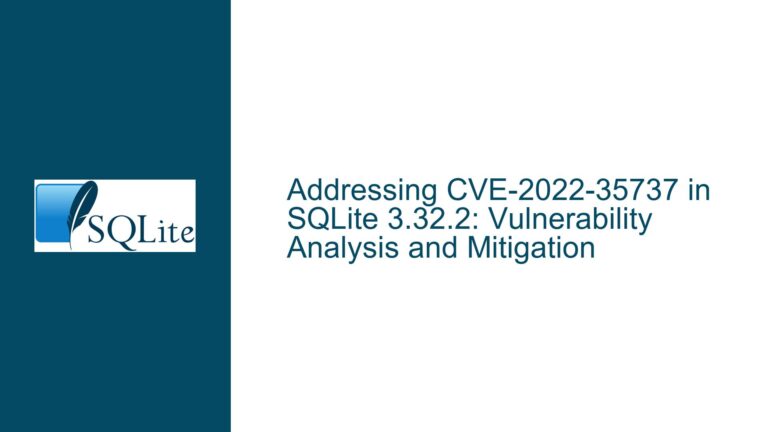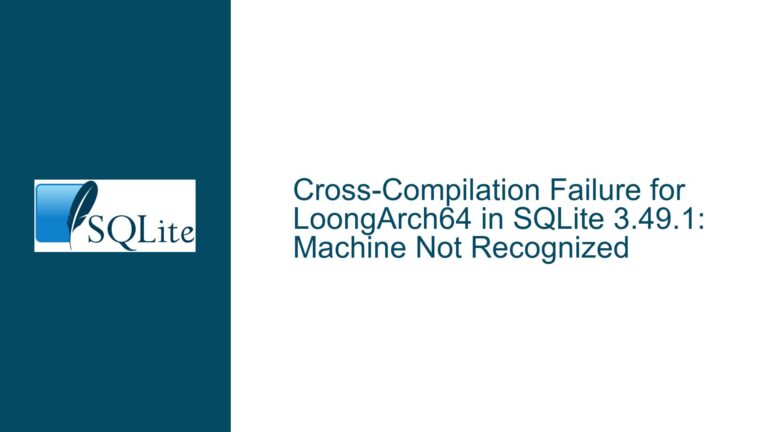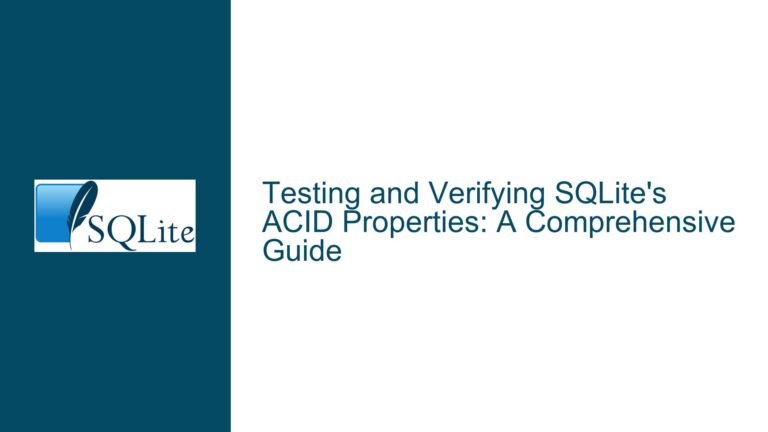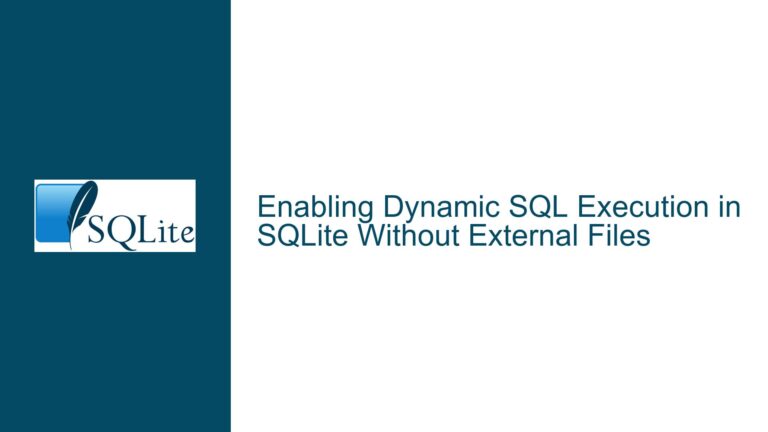Embedding SQLite Shell for Automated Query Output Formatting
Issue Overview: Generating Formatted Query Output Without Reimplementing CLI Logic
The core challenge revolves around executing arbitrary SQL queries against an SQLite database and receiving results in predefined formats (tabular, CSV) without reinventing output generation logic. Developers often face this when building applications requiring automated report generation, data exports, or integration with external systems demanding structured data. The SQLite shell (sqlite3) provides robust formatting options, leading to the natural desire to embed its functionality directly into custom programs. However, the shell is designed as an interactive command-line tool rather than a library, creating integration complexities.
Key technical constraints include handling dynamic query execution, managing I/O streams between parent and child processes, and maintaining compatibility across operating systems. The shell’s formatting logic is tightly coupled with its REPL (Read-Eval-Print Loop) architecture, making direct code reuse non-trivial. Developers must choose between subprocess orchestration, source code modification, and alternative API-driven approaches—each with distinct tradeoffs in performance, maintainability, and implementation effort.
Possible Causes: Architectural Mismatch Between CLI Design and Programmatic Use
1. Shell Tooling vs. Library Design Paradigms
The sqlite3 shell prioritizes interactive use with features like prompt handling and command history, which become irrelevant in automated scenarios. Its output formatting subsystems (e.g., .mode, .headers) assume human-readable contexts rather than machine-driven consumption. This creates friction when attempting to repurpose these components programmatically.
2. Input/Output Stream Synchronization Challenges
When invoking the shell as a subprocess, developers must precisely manage stdin/stdout/stderr pipes to avoid deadlocks. Queries containing semicolons or temporary table operations may produce unexpected intermediate output, complicating result extraction. For example, a multi-statement query might interleave data output with schema changes, requiring sophisticated parsing to isolate the desired results.
3. Limited Control Over Execution Context
Directly embedding the shell binary restricts customization of error handling, memory management, and concurrency. Applications requiring transaction control across multiple queries or those operating in resource-constrained environments may find subprocess invocation too inflexible. Additionally, environment variables like SQLITE_TMPDIR and shell-specific startup files (.sqliterc) can alter behavior unpredictably in embedded contexts.
4. Versioning and Dependency Conflicts
Tight coupling with a specific sqlite3 shell version introduces dependency management risks. System-installed shells might lack required features or security patches, while statically linking the shell’s source code complicates updates. This becomes critical when deploying across heterogeneous environments where shell behavior varies (e.g., macOS’s legacy SQLite vs. manually updated Linux binaries).
5. Security and Injection Vulnerabilities
Constructing shell commands by string concatenation exposes risks of SQL injection or shell meta-character exploits if query parameters aren’t properly sanitized. Even parameterized queries become hazardous when passed through external processes, as attackers might manipulate environment variables or configuration files affecting shell execution.
Troubleshooting Steps, Solutions & Fixes: Strategic Integration Approaches
Approach 1: Subprocess Orchestration with Pipes
Leverage the operating system’s process control APIs to execute the sqlite3 shell as a child process with redirected I/O streams. This avoids modifying SQLite’s codebase while retaining all formatting capabilities.
Implementation Steps
Pipe Configuration
Create three pipes for stdin, stdout, and stderr using platform-specific APIs:- POSIX:
pipe()+fork()+dup2() - Windows:
CreatePipe()+CreateProcess()
Redirect the child process’s stdin from a read pipe, stdout/stderr to write pipes. Non-blocking I/O is critical to prevent deadlocks when processing large datasets.
- POSIX:
Command Construction
Format the shell invocation command with essential arguments:sqlite3 -batch -noheader -csv /path/to/database.dbKey flags:
-batch: Disable interactive features-cmd "PRAGMA foreign_keys=ON;": Execute pre-query commands-init /dev/null: Ignore user configuration files
Query Wrapping
Encapsulate user-provided queries with sentinel markers for reliable output parsing:SELECT '##BEGIN_RESULT##'; -- User query here SELECT '##END_RESULT##';This allows precise extraction of result segments from stdout, avoiding noise from automatic headers or progress indicators.
Output Parsing
Implement a state machine to process stdout line-by-line:- Initial State: Discard lines until
##BEGIN_RESULT## - Capture State: Accumulate lines until
##END_RESULT## - Terminal State: Process captured lines as CSV/TSV
Handle edge cases:
- Embedded newlines in BLOB fields
- UTF-8/16 encoding mismatches
- Shell error messages interleaved with data
- Initial State: Discard lines until
Error Handling
Monitor stderr for SQLITE_ERROR messages and SIGCHLD (POSIX) / process status (Windows) for abnormal exits. Timeout mechanisms prevent hangs from long-running queries.
Example POSIX Code Skeleton
#include <unistd.h>
#include <sys/wait.h>
void execute_query(const char* db_path, const char* query) {
int stdin_pipe[2], stdout_pipe[2], stderr_pipe[2];
pipe(stdin_pipe); pipe(stdout_pipe); pipe(stderr_pipe);
pid_t pid = fork();
if (pid == 0) { // Child
dup2(stdin_pipe[0], STDIN_FILENO);
dup2(stdout_pipe[1], STDOUT_FILENO);
dup2(stderr_pipe[1], STDERR_FILENO);
execlp("sqlite3", "sqlite3", "-batch", "-csv", db_path, NULL);
exit(1);
}
// Parent: Write query to stdin_pipe[1]
const char* wrapped_query =
"SELECT '##BEGIN_RESULT##';\n"
"%s\n"
"SELECT '##END_RESULT##';\n";
write(stdin_pipe[1], wrapped_query, strlen(wrapped_query));
// Read stdout/stderr pipes with non-blocking I/O
// ... (omitted for brevity)
waitpid(pid, &status, 0);
}
Pros:
- Utilizes existing, well-tested formatting logic from sqlite3
- No compilation dependencies beyond shell binary
- Cross-platform with proper pipe handling
Cons:
- High overhead for frequent small queries
- Complex error recovery
- Security risks from unsanitized query input
Approach 2: Direct C API Integration with Custom Formatting
Bypass the shell entirely by using SQLite’s C/C++ interface directly, implementing only necessary formatting routines.
Implementation Steps
Database Connection Setup
Initialize a database handle withsqlite3_open_v2(), enabling URI filenames and strict threading mode:sqlite3* db; int flags = SQLITE_OPEN_READWRITE | SQLITE_OPEN_URI | SQLITE_OPEN_NOMUTEX; sqlite3_open_v2("file:data.db?mode=ro", &db, flags, NULL);Prepared Statement Execution
Compile user queries intosqlite3_stmtobjects withsqlite3_prepare_v3(), binding parameters usingsqlite3_bind_*()functions to prevent injection.Resultset Iteration
For each row:while (sqlite3_step(stmt) == SQLITE_ROW) { int col_count = sqlite3_column_count(stmt); for (int i = 0; i < col_count; i++) { int col_type = sqlite3_column_type(stmt, i); // Handle each data type } }CSV Formatting Implementation
Build CSV output adhering to RFC 4180:- Enclose fields containing commas/double quotes in quotes
- Escape inner quotes with double quotes
- Use CRLF line terminators
Sample escaping logic:
void csv_escape(const char* input, FILE* out) { int needs_quoting = strpbrk(input, ",\"\r\n") != NULL; if (needs_quoting) fputc('"', out); for (const char* p = input; *p; p++) { if (*p == '"') fputc('"', out); fputc(*p, out); } if (needs_quoting) fputc('"', out); }Tabular Formatting
Calculate column widths dynamically by caching maximum lengths during first result iteration, then pretty-print during a second pass. Use Unicode box-drawing characters for borders if terminal support is detected.
Memory Management Considerations
- Use
sqlite3_free()for memory allocated by SQLite - Employ prepared statement finalization to prevent leaks
- Consider memory-mapped I/O for large BLOBs via
sqlite3_blob_open()
Example CSV Output Loop
sqlite3_stmt* stmt;
sqlite3_prepare_v3(db, "SELECT * FROM sensors", -1, 0, &stmt, NULL);
// Print headers
int cols = sqlite3_column_count(stmt);
for (int i = 0; i < cols; i++) {
if (i > 0) printf(",");
csv_escape(sqlite3_column_name(stmt, i), stdout);
}
printf("\r\n");
// Print rows
while (sqlite3_step(stmt) == SQLITE_ROW) {
for (int i = 0; i < cols; i++) {
if (i > 0) printf(",");
const char* val = (const char*)sqlite3_column_text(stmt, i);
csv_escape(val ? val : "NULL", stdout);
}
printf("\r\n");
}
sqlite3_finalize(stmt);
Pros:
- Maximum performance and resource control
- Eliminates subprocess overhead
- Full parameterization and security
Cons:
- Reimplementing formatting features already in the shell
- Increased code complexity for edge cases (BLOBs, NULLs)
- Tight coupling with SQLite C API
Approach 3: Shell Source Code Modification for Embedding
Extract and adapt the sqlite3 shell’s output formatting modules into a standalone library.
Codebase Analysis
Key shell components in shell.c (SQLite amalgamation):
do_meta_command(): Handles.mode,.headers, etc.output_*(): Format-specific functions (output_csv(),output_table())ShellState: Structure holding output configuration
Refactoring Steps
Isolate Formatting Code
Create new filesformat.handformat.ccontaining:- Output mode enums (MODE_Csv, MODE_Table)
- Configuration structs mirroring
ShellState format_row()function accepting column data and mode
Decouple from Interactive Components
Remove dependencies onlinenoise(line editing),signal()handlers, and file I/O calls. Replacestdiowith a callback-based output interface:typedef void (*OutputCallback)(const char* data, void* userdata); void format_row(..., OutputCallback cb, void* userdata);Build as Shared Library
Modify the Makefile to compileformat.cinto a.aor.sofile with C-linkage symbols. Expose minimal API:FORMAT_API void format_init(int mode, int show_headers); FORMAT_API void format_row(int ncols, const char** values, OutputCallback cb, void* userdata); FORMAT_API void format_cleanup();Integrate into Application
Link against the new library and invoke formatting during query execution:void on_result(void* userdata, int ncols, char** values, char** names) { static bool headers_done = false; if (!headers_done) { format_row(ncols, names, send_output, userdata); headers_done = true; } format_row(ncols, values, send_output, userdata); } sqlite3_exec(db, query, on_result, NULL, NULL);
Challenges
- The shell’s formatting code assumes global state (
ShellState) requiring thread-local storage if used concurrently - Some output modes rely on terminal capabilities (e.g., column width autodetection) needing adaptation for non-interactive use
- Frequent merges with upstream SQLite changes complicate maintenance
Pros:
- Reuses battle-tested formatting code
- Maintains feature parity with sqlite3 shell
- Avoids subprocess and C API complexities
Cons:
- Significant initial development effort
- Requires ongoing synchronization with SQLite updates
- Potential licensing implications depending on usage
Final Recommendations
For Rapid Prototyping: Subprocess invocation with proper query wrapping and output parsing provides quick results but demands rigorous input sanitization. Best suited for low-call-frequency scenarios like nightly report generation.
High-Performance Applications: Direct C API integration with custom formatting minimizes overhead and maximizes control. Invest in a well-tested formatting library to handle edge cases across data types and locales.
Long-Term Maintenance: Forking and modifying the shell source makes sense when requiring exact replication of shell output formats. Maintain a patchset against upstream SQLite and automate regression testing against shell behavior.
Alternative Considerations:
- Use language-specific bindings (Python’s
sqlite3, Node.js’better-sqlite3) that wrap the C API and provide formatting utilities - Generate JSON output via SQL functions (
json_group_array(),json_object()) and convert to target format using lightweight libraries - Employ SQLite’s virtual table mechanism to expose results to external tools (e.g., CSV export via
.oncecommand)
Each approach balances development time, runtime efficiency, and maintenance burden. Profile performance under expected workloads and validate output correctness across diverse query types before committing to an architecture.






